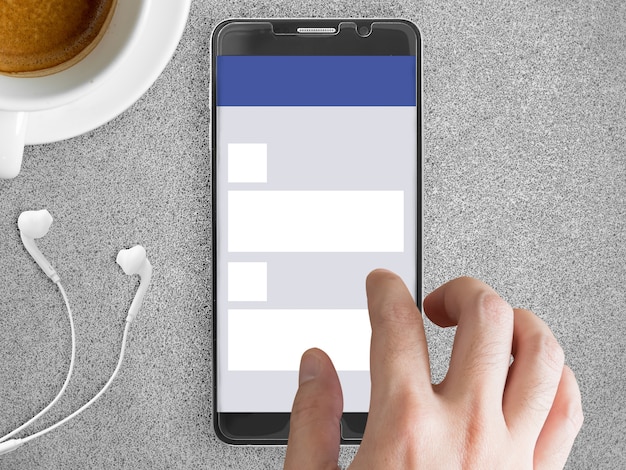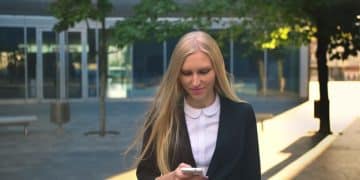Mastering Email Etiquette in 2025: Dos and Don’ts for Work Emails

Mastering email etiquette in 2025 involves understanding the evolving norms of workplace communication, including when to reply, how promptly to respond, and what tone to adopt to maintain professionalism and build strong working relationships.
Navigating the digital workplace requires a refined understanding of communication norms, especially when it comes to email. In 2025, mastering the dos and don’ts of replying to work emails: mastering digital etiquette in 2025 can significantly impact your professional relationships and career trajectory. This guide provides essential insights to help you craft effective and appropriate email responses.
Email Reply Essentials: Setting the Stage for 2025
Effective email communication is more than just typing a response; it’s about understanding the context, urgency, and recipient. Setting the stage for successful email interactions in 2025 requires awareness and adaptability to evolving workplace dynamics.
Understanding Email Urgency
Not all emails demand immediate attention. Learning to prioritize is crucial for managing your time and maintaining productivity.
Consider these factors when assessing urgency:
- Sender’s Role: Emails from your manager or direct reports often require quicker responses.
- Subject Line: Look for keywords like “Urgent” or “Action Required.”
- Content: Skim the email to identify if it contains time-sensitive requests.
Tailoring Your Tone
The tone of your email can significantly impact how your message is received. Aim for professionalism while adapting to the specific situation.
Tips for tailoring your tone:
- Know Your Audience: Adjust your formality based on your relationship with the recipient.
- Be Clear and Concise: Avoid ambiguity that could lead to misunderstandings.
- Proofread Carefully: Errors can undermine your credibility.
In conclusion, setting the stage for effective email replies involves understanding the nuances of urgency and tone. By prioritizing emails effectively and tailoring your tone to the recipient and situation, you can enhance your email communication skills and foster positive professional relationships.
The Critical Dos of Replying to Work Emails
Responding effectively to work emails is a skill that can enhance your professional image and productivity. Mastering the “dos” ensures your communications are clear, concise, and respectful.

Acknowledge Receipt Promptly
Even if you can’t provide a full response immediately, a quick acknowledgement assures the sender that their email has been received.
Best practices for acknowledgment:
- Automated Replies: Use an out-of-office reply when you’re unavailable.
- Brief Confirmation: A simple “Received, will look into this shortly” can suffice.
- Set Expectations: If you need more time, indicate when you’ll provide a full response.
Answer All Questions
Ensure you address every question or point raised in the original email. This demonstrates attentiveness and prevents the need for follow-up inquiries.
Strategies for thorough responses:
- Review Carefully: Before sending, double-check that you’ve covered all bases.
- Use Bullet Points: For complex emails, use bullet points to structure your answers.
- Seek Clarification: If a question is unclear, don’t hesitate to ask for more details.
Keep it Concise and to the Point
Time is valuable. Get straight to the point and avoid unnecessary jargon or rambling.
Techniques for concise communication:
- Use Short Paragraphs: Break up long blocks of text for readability.
- Eliminate Fluff: Cut out any words or phrases that don’t add value.
- Direct Language: Be clear and direct in your messaging.
Mastering the “dos” of email communication, such as acknowledging emails promptly, answering all questions thoroughly, and maintaining conciseness, is crucial for developing a reputation as a reliable and effective communicator in the professional sphere. By adhering to these principles, you can enhance your relationships with colleagues and clients.
Navigating the Dont’s: Email Reply Pitfalls
Just as important as knowing what to do is understanding what to avoid in your email replies. These “don’ts” can save you from miscommunications, damaged relationships, and potential professional setbacks.
Avoid Responding When Emotional
Never fire off an email when you’re angry, frustrated, or upset. Wait until you’ve cooled down and can respond rationally.
Strategies for managing emotional responses:
- Draft and Delay: Write your response but don’t send it immediately.
- Seek Input: Ask a trusted colleague to review your draft.
- Take a Break: Step away from your computer to clear your head.
Don’t Ignore the Chain of Command
Always respect the organizational hierarchy. Copy relevant parties and ensure your supervisor is informed when necessary.
Understanding chain of command:
- Know Your Company Policy: Familiarize yourself with internal communication protocols.
- CC Appropriately: Include individuals who need to be aware of the conversation.
- When in Doubt, Ask: Clarify who should be included in the email thread.
Refrain From Using All Caps
Typing in all caps is perceived as shouting and is generally considered rude and unprofessional.
Alternatives to all caps:
- Use Bold or Italics: Emphasize important words or phrases.
- Create Headings: Use headings to highlight key points.
- Careful Word Choice: Select words that convey the appropriate emphasis.
By avoiding common email pitfalls such as responding emotionally, disregarding the chain of command, and using all caps, you can maintain a professional demeanor and prevent misunderstandings. These “don’ts” are essential for effective communication in any professional setting.
Crafting the Perfect Subject Line for Replies
The subject line is your email’s first impression. A well-crafted subject line for a reply can significantly increase the likelihood of your email being opened and read promptly.

Maintain Context with “Re:”
Keep the “Re:” prefix in the subject line to maintain context and indicate you’re continuing an existing conversation.
Benefits of keeping “Re:”
- Provides Continuity: Helps recipients quickly understand the email’s context.
- Increases Relevance: Signals that the email is part of an ongoing discussion.
- Improves Organization: Allows for easier tracking and management of email threads.
Update When the Topic Shifts
If the conversation shifts to a new topic, update the subject line to reflect the change.
Best practices for updating subject lines:
- Reflect the New Focus: Ensure the subject line accurately describes the email’s content.
- Keep it Concise: Use clear and brief language to convey the new topic.
- Avoid Ambiguity: Be specific to prevent confusion among recipients.
Use Keywords for Clarity
Incorporate relevant keywords in the subject line to help recipients quickly understand the email’s purpose.
Tips for using keywords:
- Identify Core Topics: Determine the main subject(s) of the email.
- Use Specific Terms: Opt for precise keywords over generic phrases.
- Prioritize Relevance: Ensure the keywords are directly related to the email’s content.
Crafting effective subject lines for email replies requires maintaining context, updating when necessary, and incorporating keywords for clarity. By paying attention to these details, you can increase the effectiveness of your email communication and reduce the likelihood of your emails being overlooked.
Emailing Across Cultures: Sensitivity in 2025
In an increasingly globalized workplace, cultural sensitivity in email communication is essential for avoiding misunderstandings and building strong international relationships. 2025 requires a refined understanding of diverse communication styles.
Research Cultural Norms
Before emailing someone from a different culture, research their communication norms to avoid unintentional offense.
Key areas to research:
- Formality: Understand the appropriate level of formality for email interactions.
- Directness: Determine whether direct or indirect communication is preferred.
- Communication Style: Be aware of differences in communication styles, such as emphasis on personal relationships versus task orientation.
Be Mindful of Language
Avoid jargon, slang, and idioms that may not translate well or could be misinterpreted.
Language best practices:
- Use Clear and Simple Language: Opt for straightforward wording to minimize confusion.
- Avoid Colloquialisms: Refrain from using slang or idioms that may not be universally understood.
- Proofread Carefully: Ensure your email is free of grammatical errors and typos.
Respect Time Zones
Be considerate of different time zones when sending emails, and avoid expecting immediate responses outside of working hours.
Tips for respecting time zones:
- Schedule Emails: Use scheduling tools to send emails during the recipient’s working hours.
- Acknowledge Time Differences: Apologize for any inconvenience caused by the timing of your email.
- Be Flexible: Understand that response times may vary due to time zone differences.
Emailing across cultures in 2025 necessitates sensitivity to cultural norms, careful language use, and respect for time zones. By adhering to these principles, you can foster positive international relationships and avoid misunderstandings in cross-cultural communication.
Future-Proofing Your Email Etiquette
As technology and workplace dynamics evolve, so too must your email etiquette. Staying adaptable and proactive is key to mastering digital communication in the long term.
Staying Updated on Digital Trends
Keep abreast of emerging digital communication trends and adapt your email etiquette accordingly.
Strategies for staying updated:
- Follow Industry Blogs: Read articles and insights on digital communication.
- Attend Webinars: Participate in webinars on email etiquette and workplace trends.
- Network with Professionals: Engage with peers and experts to learn about new best practices.
Embracing New Technologies
Explore and embrace new technologies and platforms that enhance email communication and collaboration.
Emerging technologies to consider:
- AI-Powered Tools: Use AI tools for email summarization, drafting, and proofreading.
- Collaboration Platforms: Integrate email with project management and team collaboration tools.
- Enhanced Security Measures: Implement advanced security measures to protect email communications.
Continuous Improvement
Seek feedback on your email communication skills and strive for continuous improvement.
Practices for ongoing improvement:
- Solicit Feedback: Ask colleagues and managers for constructive criticism.
- Reflect on Interactions: Analyze your email communications to identify areas for improvement.
- Practice Mindful Communication: Pay attention to the impact of your words and tone.
Future-proofing your email etiquette involves keeping updated on digital trends, embracing new technologies, and committing to continuous improvement. By staying adaptable and proactive, you can ensure your email communication remains effective and professional in the years to come.
| Key Element | Brief Description |
|---|---|
| ⏰ Acknowledge Promptly | Acknowledge receipt quickly, even if a full response isn’t immediate. |
| ✍️ Answer Completely | Address all questions and points in the original email. |
| 🚫 Avoid Caps | Refrain from using all caps, as it’s seen as shouting. |
| 🌏 Cultural Sensitivity | Be mindful of cultural norms when emailing internationally. |
Frequently Asked Questions
Aim to reply within 24-48 hours, depending on the sender’s role and the email’s urgency. Acknowledge receipt if you need more time to provide a complete response.
Before responding, take a moment to calm down. If necessary, ask a colleague to check your answer before submitting to make sure it sounds professional.
Keep paragraphs short and use bullet points or numbered lists to structure information. Ensure your subject lines are concise and descriptive.
Emojis can add tone, but use them sparingly and consider your audience. Avoid using them in formal communications or when emailing senior management.
Practice writing regularly, seek feedback from colleagues, and actively read and analyze effective email communications. Consider courses or workshops on business writing.
Conclusion
Mastering the art of email communication is essential for success in today’s professional world. By following these guidelines, you can enhance your digital interactions, build stronger relationships, and maintain a positive professional presence.



